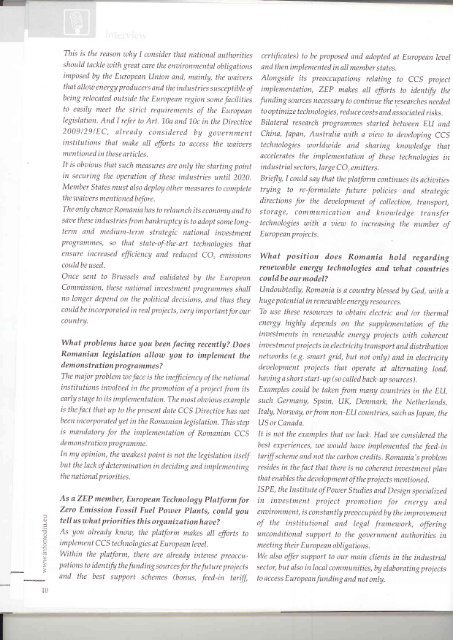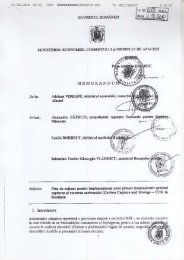Create successful ePaper yourself
Turn your PDF publications into a flip-book with our unique Google optimized e-Paper software.
I<br />
5<br />
ar<br />
.il<br />
q)<br />
fr<br />
.E<br />
:l<br />
.i:<br />
s<br />
I r'1<br />
This is the reason why I consider that nntional authorities<br />
should tackle with great care the enaironmental obligations<br />
imposed by the European Llnion and, mainly, the wsiaers<br />
thst allow energy producers and the industries susceptible of<br />
being relocated outside the European region some facilities<br />
to easily meet the strict requirements of the European<br />
legislation. And I refer to Art. 10a and 10c in the Directiae<br />
20091291EC, already considered by gouernment<br />
institutions that make nll ffirts to access the waiaers<br />
mentioned in these articles.<br />
It..is obaious that such measures are only the starting point<br />
in securing the operation of these industries until 2020.<br />
Member States must also deploy other measures to complete<br />
the w aia er s mentione d b efor e.<br />
The only chance Romaniahas to relaunch its economy and to<br />
saae these industries from bankruptcy is to adopt some longterm<br />
nnd medium-term strategic national inaestment<br />
progrnmmes, so that stnte-of-the-art technologies that<br />
ensure increased efficiency and reduced CO, emissions<br />
couldbe used.<br />
Once sent to Brussels qnd aalidnted by the European<br />
Commission, these national inaestment progrnmmes shall<br />
no longer depend on the political decisions, and thus they<br />
couldbe incorporated in real projects, ztery important for our<br />
country.<br />
rhrhat problems haoe you been facing recently? Does<br />
Romanian legislation allow you to implement the<br />
d em o n s tr ati o n p r o gr amm e s ?<br />
The major problem we face is the inefficiency of the national<br />
institutions inaolaed in the promotion of a project from its<br />
early stage to its implementation. The most obaious example<br />
is the fnct that up to the present date <strong>CCS</strong> Directiae hns not<br />
been incorporatedyet in the Romanianlegislntion. This step<br />
is mandatory for the implementation of Romanian <strong>CCS</strong><br />
demonstr ation pro gr nmme.<br />
In my opinion, the weakest point is not the legislation itself<br />
but the lack of determination in deciding nnd. implementing<br />
the national priorities.<br />
As a ZEP membery European Technology platform<br />
for<br />
Zero Emission Fossil Fuel Pouter plants, could you<br />
tell us what priorities this organizationhaoe?<br />
As you already know, the platform makes all efforts to<br />
implement <strong>CCS</strong> technologies at Europeanleuel.<br />
Within the platform, there are already intense preoccupations<br />
to identfu the funding sources for the<br />
certificates) to be proposed and adopted at European leael<br />
and then implementedin allmember states.<br />
Alongside its preoccuptttions relating to <strong>CCS</strong> project<br />
implementation, ZEP makes aII efforts to identifu the<br />
funding sources necessary to continue the researches needed<br />
to optimize technologies, reduce costs and associatedrisks.<br />
Bilateral research programmes started between EII snd<br />
China, lapan, Australis with a aiew to deaeloping <strong>CCS</strong><br />
technologies raorldrnide snd sharing knowledge thst<br />
accelerqtes the implementation of these technologies in<br />
indus tr ial s ect or s, lar ge CO, emitt er s.<br />
Briefly, I could say that the platform continues its actiaities<br />
trying to re-formulate future policies and strategic<br />
directions for the deaelopment of collection, transport,<br />
storage, communication qnd knowledge transfer<br />
technologies with a aiern to increasing the number of<br />
Europeanprojects.<br />
What position does Romania hold regarding<br />
renewable energy technologies and rahat countries<br />
couldbe ourmodel?<br />
Undoubtedly, Romania is a country blessedby God, with a<br />
hu ge potential in renew able ener gy resources.<br />
To use these resources to obtain electric and lor thermal<br />
energy highly depends on the supplementation of the<br />
inaestments in renewable energy projects with coherent<br />
inaestment projects in electricity transport and distribution<br />
networks (e.g. smart grid, but not only) and in electricity<br />
deaelopment projects that operate at slternating load,<br />
haaing a short start-up (so calledback-up sources).<br />
Examples could be taken from many countries in the ELI,<br />
such Germany, Spain, UK, Denmnrk, the Netherlands,<br />
Italy, Norway, or from non-EI-I countries, such as lapnn, the<br />
US or Cnnada.<br />
It is not the examples that we lack. Had we considered the<br />
best experiences, u)e zuould haae implemented the feed-in<br />
tariff scheme and not the csrbon credits. Romania's problem<br />
resides in the fact that there is no coherent inaestment plnn<br />
that enables the deuelopment of the projects mentioned.<br />
ISPE, the Institute of Pozuer Studies and Design specialized<br />
in inaestment project promotion for energy and<br />
enaironment, is constantly preoccupied by the improuement<br />
of the institutional and legal framework, offering<br />
unconditional support to the goaernment authorities in<br />
meetin g their Europ e an obli gations.<br />
We also offer support to our main clients in the industrial<br />
future proj ects sector, but also inlocsl communities, by elaboratingprojects<br />
qnd the best support schemes (bonus,<br />
feed-in tariff, to access Europeanfunding andnot only.




